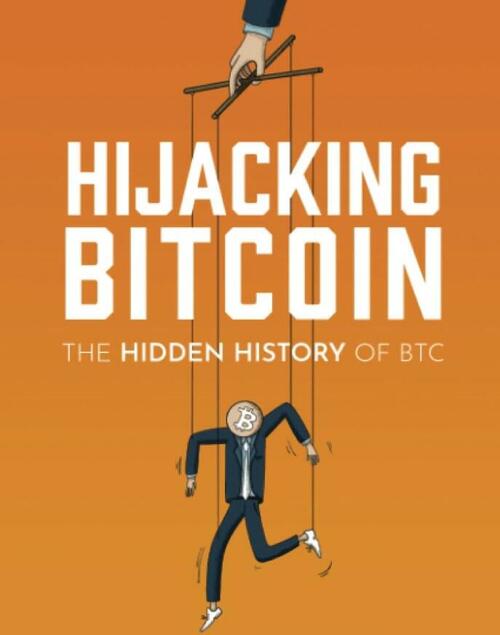
What Happened To Bitcoin?
Authored by Jeffrey Tucker via The Brownstone Institute,
Those who involved themselves in Bitcoin markets after 2017 encountered a different operation and ideal than those who came before. Today, no one much cares about what came before, speaking of 2010-2016. They are only watching the upward price momentum and are thrilled for the increase in the asset valuation of their portfolio.

Gone is the talk of separating money and state, of a market-based means of exchange, of genuine revolution that would extend from money to the whole of politics the world over. And gone is the talk of changing the operation of money as a means of changing the prospects for freedom itself. The enthusiasts around Bitcoin have different goals in mind.
And during this entire period, the exact time when this digital asset might have protected multitudes of users and businesses from rapacious inflation growing out of the worst and most globalized experience of corporatist statism in modern history, made possible due to the money monopoly of central banks that funded the operation, the original asset that carries the symbol BTC was systematically diverted from its original purpose.
The ideal was nicely articulated by F.A. Hayek in 1974. Much of his career as an economist was spent arguing for sound monetary policies. At every important turning point, he faced the same problem: governments and the institutions they serve did not want sound money. They wanted to manipulate the currency system to benefit elites, not the public. Finally, he refined his argument. He concluded that the only real answer was a complete divorce of money and power.
“Nothing can be more welcome than depriving government of its power over money and so stopping the apparently irresistible trend towards an accelerating increase of the share of the national income it is able to claim,” he wrote in 1976 (two years after his Nobel Prize).
“If allowed to continue, this trend would in a few years bring us to a state in which governments would claim 100 per cent of all resources—and would in consequence become literally ‘totalitarian’.”
“It may turn out that cutting off government from the tap which supplies it with additional money for its use may prove as important in order to stop the inherent tendency of unlimited government to grow indefinitely, which is becoming as menacing a danger to the future of civilisation as the badness of the money it has supplied.”
The problem in achieving this ideal was technical and institutional. So long as state money worked, there was no real drive to change it. Certainly the push would never come from the ruling classes who benefit from the present system, which is precisely where every old argument for the gold standard faltered. How to get around this problem?
In 2009, a pseudonymous developer or group released a white paper, written in language for computer scientists and not economists, for a peer-to-peer system of digital cash. For most economists at the time, its functioning was opaque and not quite believable. The proof came in the functioning itself which unfolded over the course of 2010. To summarize, it deployed a distributed ledger, double-key cryptography, and a protocol of fixed quantity to release a new form of money that operationally tied together money itself and a settlement system in one.
In other words, Bitcoin achieved the ideal about which Hayek could only dream. The key to making it all possible was the distributed ledger itself, which relied on the internet to globalize the nodes of operation, bringing a new form of accountability we had never seen in operation before. The notion of melding together the means of payment plus the mechanisms of settlement on this scale was something that had previously not been possible. And yet there it was, earning its way into the market with ever increasing valuations made possible by the distributed ledger.
So, yes, I became an early enthusiast, writing hundreds of articles, even publishing a book in 2015 called Bit By Bit: How P2P Is Freeing the World.
I could not have known it at the time, but those were in fact the last days of the ideal and just before the protocol came to be controlled by a consolidated group of developers who jettisoned entirely the idea of peer-to-peer cash to turn it into a high-earning digital security, not a competitor with state-based money but rather an asset designed not to use but hold with third-party intermediaries controlling access.
We saw all this unfold in real time and many of us were aghast. All that is left to us is to tell the story, which has not been done in a complete form until now. Roger Ver’s new book Hijacking Bitcoin does the job. It is a book for the ages simply because it lays out all the facts of the case and lets readers come to their own conclusion.

I was honored to write the foreword, which follows:
The story you will read here is of tragedy, the chronicle of an emancipationist monetary technology subverted to other ends. It’s a painful read, to be sure, and the first time this story has been told with this much detail and sophistication. We had the chance to free the world. That chance was missed, likely hijacked and subverted.
Those of us who watched Bitcoin from the earliest days saw with fascination how it gained traction and seemed to offer a viable alternative path for the future of money. At long last, after thousands of years of government corruption of money, we finally had a technology that was untouchable, sound, stable, democratic, incorruptible, and a fulfillment of the vision of the great champions of freedom from all history. At last, money could be liberated from state control and thus achieve economic rather than political goals—prosperity for everyone versus war, inflation, and state expansion.
That was the vision in any case. Alas, it did not happen. Bitcoin adoption is lower today than it was five years ago. It is not on a trajectory of final victory but on a different path to gradually increase in price for its earlier adopters. In short, the technology was betrayed by small changes that hardly anyone understood at the time.
I certainly did not. I had been playing with Bitcoin for a few years and was mainly astounded at the speed of settlement, the low cost of transactions, and the ability for anyone without a bank to send or receive it without financial mediation. That’s a miracle about which I wrote rhapsodically at the time. I held a CryptoCurrency Conference in Atlanta, Georgia, in October 2013 that focused on the intellectual and technical side of things. It was among the first national conferences on the topic, but even at this event, I noticed two sides coalescing: those who believed in monetary competition and those whose sole commitment was to one protocol.
My first clue that something had gone wrong came two years later, when for the first time I saw that the network had been seriously clogged. Transaction fees soared, settlement slowed to a crawl, and vast numbers of on-ramps and off-ramps were closing due to high compliance costs. I did not understand. I reached out to a number of experts who explained to me about a quiet civil war that had developed within the crypto world. The so-called “maximalists” had turned against widespread adoption. They liked the high fees. They did not mind the slow settlements. And many were involving themselves in the dwindling number of crypto exchanges that were still in operation thanks to a government crackdown.
At the same time, new technologies were becoming available that vastly improved the efficiency and availability of exchange in fiat dollars. They included Venmo, Zelle, CashApp, FB payments, and many others besides, in addition to smartphone attachments and iPads that enabled any merchant of any size to process credit cards. These technologies were completely different from Bitcoin because they were permission-based and mediated by financial companies. But to users, they seemed great and their presence in the marketplace crowded out the use case of Bitcoin at the very time that my beloved technology had become an unrecognizable version of itself.
The forking of Bitcoin into Bitcoin Cash occurred two years later, in 2017, and it was accompanied by great cries and screams as if something horrible was happening. In fact, all that was happening was a mere restoration of the original vision of the founder Satoshi Nakamoto. He believed with the monetary historians of the past that the key to turning any commodity into widespread money was adoption and use. It’s impossible to even imagine conditions under which any commodity could take on the form of money without a viable and marketable use case. Bitcoin Cash was an attempt to restore that.
The time to ramp up adoption of this new technology was 2013-2016, but that moment was squeezed in two directions: the deliberate throttling of the ability of the technology to scale and the push of new payment systems to crowd out the use case. As this book demonstrates, by late 2013, Bitcoin had already been targeted for capture. By the time Bitcoin Cash came to the rescue, the network had changed its entire focus from use to holding what we have and building second-layer technologies to deal with the scaling issues. Here we are in 2024 with an industry struggling to find its way within a niche while the dreams of a “to-the-moon” price are fading into memory.
This is the book that had to be written. It is a story of a missed opportunity to change the world, a tragic tale of subversion and betrayal. But it is also a hopeful story of efforts we can make to ensure that the hijacking of Bitcoin is not the final chapter. There is still the chance for this great innovation to liberate the world but the path from here to there turns out to be more circuitous than any of us ever imagined.
Roger Ver does not blow his own trumpet in this book, but he truly is a hero of this saga, not only deeply knowledgeable of the technologies but also a man who has clung to an emancipatory vision of Bitcoin from the earliest days through the present. I share his commitment to the idea of peer-to-peer currency for the masses, alongside a competitive marketplace for free-enterprise monies. This is a hugely important documentary history, and the polemic alone will challenge anyone who believes himself to be on the other side. Regardless, this book had to exist, however painful. It’s a gift to the world.
Does this story seem familiar? Indeed it does. We’ve seen this trajectory in sector after sector. Institutions born and built by ideals are later converted by various forces of power, access, and nefarious intent into something else entirely. We’ve seen this happen to digital tech in particular and the Internet generally, not to mention medicine, public health, science, liberalism, and so much else. The story of Bitcoin follows the same trajectory, a seemingly immaculate conception turned toward a different purpose, and serving again as a reminder that on this side of heaven, there will never be an institution or idea immune to compromise and corruption.
Tyler Durden
Fri, 04/19/2024 – 06:30

 1 rok temu
1 rok temu












